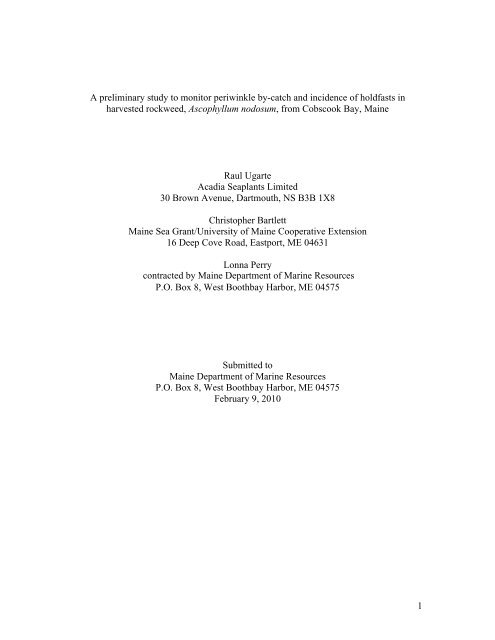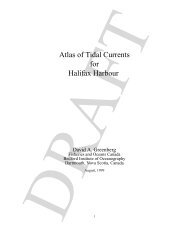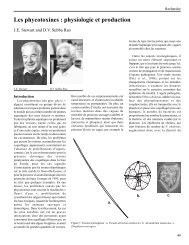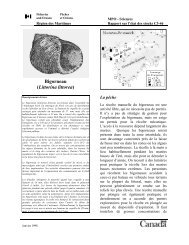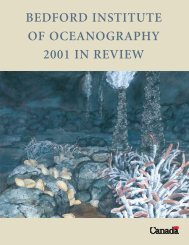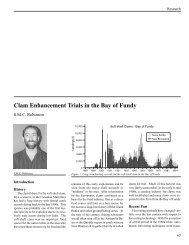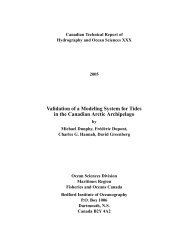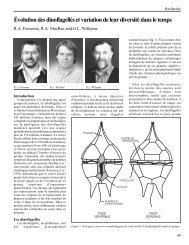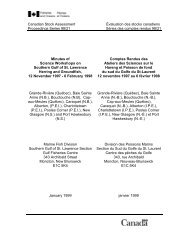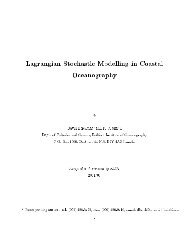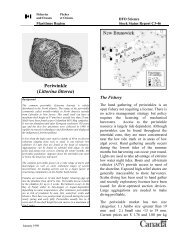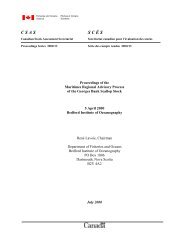P. Ugarte et al. - periwinkle
P. Ugarte et al. - periwinkle
P. Ugarte et al. - periwinkle
You also want an ePaper? Increase the reach of your titles
YUMPU automatically turns print PDFs into web optimized ePapers that Google loves.
A preliminary study to monitor <strong>periwinkle</strong> by-catch and incidence of holdfasts in<br />
harvested rockweed, Ascophyllum nodosum, from Cobscook Bay, Maine<br />
Raul <strong>Ugarte</strong><br />
Acadia Seaplants Limited<br />
30 Brown Avenue, Dartmouth, NS B3B 1X8<br />
Christopher Bartl<strong>et</strong>t<br />
Maine Sea Grant/University of Maine Cooperative Extension<br />
16 Deep Cove Road, Eastport, ME 04631<br />
Lonna Perry<br />
contracted by Maine Department of Marine Resources<br />
P.O. Box 8, West Boothbay Harbor, ME 04575<br />
Submitted to<br />
Maine Department of Marine Resources<br />
P.O. Box 8, West Boothbay Harbor, ME 04575<br />
February 9, 2010<br />
1
Introduction<br />
Commerci<strong>al</strong>-sc<strong>al</strong>e harvest of the brown seaweed Ascophyllum nodosum (rockweed) in<br />
Cobscook Bay began in the mid 1990s, with intermittent annu<strong>al</strong> landings not exceeding<br />
363 MT (400 short tons). In recent years, a more organized operation has increased<br />
landings, with 2722 MT harvested in 2008. The 2009 landings decreased to about 1090<br />
MT, in part due to the division of the bay b<strong>et</strong>ween two harvesting companies and<br />
conserved lands that were prohibited for harvest. Acadia Sea Plants harvested 997 MT<br />
and Butch Harris of Eastport harvested 93.5 MT in 2009, respectively. The biomass of<br />
rockweed in Cobscook Bay is estimated to be 50,000 tons without the exclusion of<br />
conserved lands.<br />
Questions exist about the effect of rockweed harvesting on other commerci<strong>al</strong> and noncommerci<strong>al</strong><br />
species. Fishermen in Cobscook Bay raised concerns about the quantities of<br />
<strong>periwinkle</strong>s that were caught incident<strong>al</strong> to the rockweed harvest. The common<br />
<strong>periwinkle</strong>, Littorina littorea, is an abundant commerci<strong>al</strong>ly exploited snail found among<br />
the intertid<strong>al</strong> rockweed beds. Statewide landings of the common <strong>periwinkle</strong> tot<strong>al</strong>ed<br />
720,004 pounds in 2008 with an estimated v<strong>al</strong>ue of $601,410 (Maine DMR). To address<br />
this concern, we implemented a preliminary monitoring study to ev<strong>al</strong>uate the abundance<br />
of three <strong>periwinkle</strong> species found as by-catch in harvested rockweed.<br />
In addition, the incidence of plants harvested with and without holdfasts was ev<strong>al</strong>uated to<br />
provide information on the proportion of plants dislodged during the harvest. Sexu<strong>al</strong><br />
reproduction has been claimed to be a poor mechanism to maintain rockweed beds<br />
(Vadas 1990), with the holdfast being the portion of the plants that plays the important<br />
role of regenerating new shoots (fig. 1). Thus the portion of plants harvested with<br />
holdfast tissue is an important param<strong>et</strong>er to ev<strong>al</strong>uate potenti<strong>al</strong> changes in the resource<br />
dynamic and habitat architecture.<br />
This report presents the results of a monitoring program carried out b<strong>et</strong>ween September<br />
17 and October 13, 2009 with harvesters contracted by Acadia Sea Plants Limited (ASL)<br />
during the fin<strong>al</strong> weeks of their season<strong>al</strong> operations. We <strong>al</strong>so intended to monitor the<br />
rockweed harvests of Butch Harris, an affiliate of North American Kelp. Unfortunately,<br />
Mr. Harris experienced equipment problems during our sampling period and we were not<br />
able to collect meaningful information from his operations.<br />
M<strong>et</strong>hods<br />
Sampling procedure<br />
ASL contractors use a cutter rake to hand-harvest rockweed and load it into open boats<br />
for transfer to a storage site. Harvesters operated two to five boats on a daily basis during<br />
the study timeframe. After the daily harvest was compl<strong>et</strong>ed, three ~6 kg samples of<br />
rockweed per boat were randomly collected in plastic bags. Care was taken to include <strong>al</strong>l<br />
<strong>periwinkle</strong>s and not break or tear off any rockweed clumps with holdfasts in the sample.<br />
In addition, once the boat was compl<strong>et</strong>ely unloaded, <strong>al</strong>l <strong>periwinkle</strong>s remaining in the<br />
bottom of the boat were collected by draining the water and sieving the sample through a<br />
2.0 mm mesh screen, and <strong>al</strong>l anim<strong>al</strong>s placed inside a plastic bag with label. Each label<br />
contained the following information: boat #, harvester’s name, harvesting sector, date and<br />
2
time. These two m<strong>et</strong>hods of sampling provided an estimate of the numbers and biomass<br />
of <strong>periwinkle</strong>s in the harvested materi<strong>al</strong>.<br />
By-catch an<strong>al</strong>ysis<br />
In the lab, tot<strong>al</strong> weight of each rockweed sample was taken to the nearest gram. The<br />
sample was then washed with freshwater over a container to receive the <strong>periwinkle</strong>s. The<br />
container’s contents were then sieved through 2.0 mm screen. The snail species contained<br />
in the samples were identified using a taxonomic key (A Preliminary Guide to the Littor<strong>al</strong><br />
and Sublittor<strong>al</strong> Marine Invertebrates of Passamaquoddy Bay, Brinkhurst, D.S., <strong>et</strong> <strong>al</strong>.).<br />
Snails from each of three species were separated, counted, and the tot<strong>al</strong> weight measured<br />
to the nearest 0.01 g (see photos). The same procedure was followed with snail samples<br />
recovered from the boat at the end of the unloading process.<br />
Holdfast an<strong>al</strong>ysis<br />
Once washed, the rockweed sample was spread out and clumps containing holdfasts were<br />
separated, counted and weighed individu<strong>al</strong>ly to the nearest 0.1g. The tot<strong>al</strong> mass of the<br />
clumps with holdfasts was then divided by the tot<strong>al</strong> mass of the sample to estimate a<br />
proportion or incidence. Four param<strong>et</strong>ers were measured per clump: tot<strong>al</strong> length (to the<br />
nearest 0.1 cm), w<strong>et</strong> weight (to the nearest 0.1g), number of shoots emerging from the<br />
holdfast in the clump, and holdfast area (to the nearest 1.0 mm). The latter was<br />
d<strong>et</strong>ermined by making an ink impression of the holdfast base on a piece of white paper.<br />
This impression was then scanned, saved in JPEG format, and the area measured with an<br />
image an<strong>al</strong>ysis program (ImageJ).<br />
Results<br />
The company’s tot<strong>al</strong> harvest of rockweed in Cobscook Bay during the entire 2009 season<br />
was 997 MT (1,099 tons). Of the 11 sectors ASL harvested, 4 sectors were harvested<br />
during the monitoring period ( fig. 2) and provided nearly 60% of ASL’s over<strong>al</strong>l 2009<br />
landed biomass. A tot<strong>al</strong> of 31 boats containing harvested rockweed were sampled<br />
b<strong>et</strong>ween September 17 and October 13, 2009 with 93 samples (3 per boat) collected.<br />
Samples averaged 6.4 kg, and the sampled boats contained an average of 3.4 MT of<br />
rockweed.<br />
Snail by-catch<br />
Three species of snail were identified and measured; the rough <strong>periwinkle</strong> Littorina<br />
saxatilis, the smooth <strong>periwinkle</strong> Littorina obtusata, and the common <strong>periwinkle</strong> Littorina<br />
littorea.<br />
Rockweed samples<br />
L. obtusata was the most abundant by-catch component in the rockweed samples with<br />
0.84 g /kg of harvested rockweed. The least abundant by-catch in the harvested materi<strong>al</strong><br />
was the commerci<strong>al</strong>ly important L. littorea with 0.18 g/kg . If we assume this by-catch<br />
rate to be consistent throughout the entire 2009 rockweed harvest in Cobscook Bay, then<br />
3
L. obtusata, represented 64.9 % of the tot<strong>al</strong> by-catch, L. saxatilis (21.9%) and L. littorea<br />
(13.3%) (Table I). The average weight of individu<strong>al</strong> <strong>periwinkle</strong>s in our samples was 0.09<br />
grams for L. obtusata, 0.10 grams for L. saxatilis, and 2.2 grams for L. littorea.<br />
Other species including blue mussel, Mytilus edulis, and dog whelk, Nucella lapillus,<br />
were found in sm<strong>al</strong>l numbers and not included in this preliminary an<strong>al</strong>ysis.<br />
Boat deck samples<br />
Contrary to the rockweed samples, the most abundant by-catch component on the boat<br />
deck samples was the common <strong>periwinkle</strong> L. littorea. However, its tot<strong>al</strong> weight as bycatch<br />
for the season was much lower than in the seaweed samples (72.1 kg). L. obtusata<br />
followed with 44.9 kg and L. saxatilis with 5.5kg (Table II).<br />
Table I. Snail by-catch estimates from harvested rockweed samples<br />
Sample an<strong>al</strong>ysis<br />
Snails in sample Tot<strong>al</strong> by-catch<br />
Snails species (g/kg) (MT/997MT)<br />
Smooth 0.861 0.858 (64.9%)<br />
Rough 0.129 0.289 (21.9%)<br />
Common 0.078 0.175 (13.3%)<br />
Tot<strong>al</strong><br />
1.32 MT<br />
Table II. Snail by-catch estimates from the decks of boats after unloading.<br />
Snails on boat after harvest<br />
Snails per boat Tot<strong>al</strong> snails<br />
Snails species (g/boat) (kg/997 MT)<br />
Smooth 149.80 44.5<br />
Rough 18.40 5.3<br />
Common 240.70 71.5<br />
Tot<strong>al</strong><br />
* average boatload was 3.4 MT<br />
121.3 kg<br />
4
Holdfast an<strong>al</strong>ysis<br />
The incidence of harvested plants containing holdfast tissue in Cobscook Bay during our<br />
sampling period was 7.78%. The average weight of these plants was 147.5 g, with an<br />
average length of 95.7 cm and containing an average of 3.3 attached shoots. The average<br />
size of the d<strong>et</strong>ached holdfast tissue was 15.3 mm 2 . Table III shows the d<strong>et</strong>ails of this<br />
an<strong>al</strong>ysis.<br />
Table III. Incidence of holdfasts and their morphology in the rockweed harvest in<br />
Cobscook Bay in 2009<br />
Incidence Weight Length No shoots Holdfast area<br />
(%) (g) (cm) (mm2)<br />
X 7.78 147.5 95.7 3.3 15.3<br />
SD 129.6 30.2 1.7 12.6<br />
n 93 151 151 151 151<br />
Most of the plants (73.5%) with holdfast tissue weighed less than 200 g, and 47% were<br />
less than 100 g (Fig 1).<br />
Figure 1. Weight distribution of plants bearing holdfast tissue<br />
The length distribution of the plants bearing holdfast tissue varied from 27 cm to 182 cm,<br />
with 75% of the plants being below 115 cm (Fig. 2).<br />
5
Figure 2. Length distribution of plants bearing holdfast tissue.<br />
The number of shoots contained in the plants bearing holdfast tissue varied from 1 to 10<br />
in the an<strong>al</strong>yzed samples. 80% of the plants contained 4 shoots or less (Fig. 3).<br />
Figure 3. Number of shoot in plants bearing holdfast tissue.<br />
6
The size of the holdfast tissue (measured as area) contained in the plants bearing holdfast<br />
varied from 2.3 mm2 to 77.2 mm2, with 80% of them being below 20 mm2 (Fig. 4)<br />
Figure 4. Size distribution of the holdfasts tissue in plants bearing holdfast.<br />
Discussion<br />
By-catch<br />
The an<strong>al</strong>ysis of harvested rockweed samples collected from Cobscook Bay in 2009<br />
showed that the dominant by-catch component was the smooth <strong>periwinkle</strong>, Littorina<br />
obtusata, with an estimated tot<strong>al</strong> of 0.86 MT removed with the rockweed during the<br />
entire harvest season. We estimated that an addition<strong>al</strong> 44.5 kg was left on the deck of the<br />
boats that harvesters would r<strong>et</strong>urn to the sea after the rockweed is transferred. L. obtusata<br />
feeds predominantly on rockweed and it was found in <strong>al</strong>l of our study’s samples.<br />
Remov<strong>al</strong> of the rough <strong>periwinkle</strong>, Littorina saxatilis, was estimated to be 0.289 MT with<br />
the harvested rockweed and an addition<strong>al</strong> 5.47 kg found on the deck of the boats. It was<br />
identified 72% of the time in rockweed samples and 100% in boat samples. L. saxatilis is<br />
most commonly found in the upper intertid<strong>al</strong> zone.<br />
The commerci<strong>al</strong>ly harvested common <strong>periwinkle</strong>, Littorina littorea, was the least<br />
abundant by-catch snail species with 0.175 MT removed with the rockweed and 71.7 kg<br />
left on the boats, for a tot<strong>al</strong> estimated loss of 243.4 kg during 2009. The average size of L.<br />
littorea was 2.2 g in our samples, making the bulk of these snails below mark<strong>et</strong> size (><br />
5.0 g in NB). This species was identified in 93% of boat samples but only 20% of<br />
rockweed samples, suggesting that it may be dislodged more readily than the other snails<br />
when the rockweed is cut and loaded into the boats. The relatively sm<strong>al</strong>l size of<br />
individu<strong>al</strong> snails in our samples <strong>al</strong>so raises the question of wh<strong>et</strong>her larger snails fell off in<br />
7
the water or wh<strong>et</strong>her sm<strong>al</strong>ler (i.e. younger) snails were more prev<strong>al</strong>ent in the upper<br />
canopy.<br />
Tot<strong>al</strong> weight of snails removed from the intertid<strong>al</strong> of Cobscook Bay in 2009 by Acadia<br />
Seaplants was estimated to be 1.44 MT, which includes boat loss. While we have<br />
documented the amount of <strong>periwinkle</strong>s taken in the rockweed harvest, further research is<br />
needed to ev<strong>al</strong>uate the direct impact on the snail population. Studies to assess the biomass<br />
of these species <strong>al</strong>ong the intertid<strong>al</strong> zone of Cobscook Bay are required to estimate the<br />
rate of by-catch mort<strong>al</strong>ity. Average densities of L. littorea on the rockweed canopy in a<br />
harvest experiment carried out at Shackford Head in Cobscook Bay in 2008 (Trott and<br />
Larsen, 2009) showed L. littorea densities in the canopy of approx 45 individu<strong>al</strong>s per m-2<br />
and 140 individu<strong>al</strong>s per m-2 in the substrate. If similar densities exist <strong>al</strong>ong <strong>al</strong>l rockweed<br />
beds of Cobscook Bay, the tot<strong>al</strong> biomass of L. littorea on rockweed covered areas would<br />
be around 2,327 MT. If this were the case, then approximately 0.008% of the<br />
commerci<strong>al</strong> <strong>periwinkle</strong> population would be taken by the harvest from the rockweed beds<br />
in 2009. We know that L. littorea is <strong>al</strong>so found in the open intertid<strong>al</strong>, thus the impact on<br />
the tot<strong>al</strong> population could be much lower. Documenting the common <strong>periwinkle</strong><br />
landings in Cobscook Bay and rates of natur<strong>al</strong> mort<strong>al</strong>ity would further inform the<br />
potenti<strong>al</strong> impact of by-catch mort<strong>al</strong>ity on this fishery.<br />
Using Trott and Larsen (2009) density estimations for the other snail species, then<br />
approximately 0.044% of the tot<strong>al</strong> snail population found on rockweed beds was removed<br />
during the 2009 harvest.<br />
Holdfast an<strong>al</strong>ysis<br />
Holdfast incidence in the harvested materi<strong>al</strong> can be the result of a friable substrate<br />
holding the rockweed clumps, a natur<strong>al</strong>ly damaged clump, or the condition of the<br />
harvesting tool. The 7.78 % holdfast incidence estimated for Cobscook Bay in 2009<br />
corresponded to 77.7 MT of biomass being harvested with holdfast tissue. This incidence<br />
was slightly higher than the incidence found in the Canadian harvest (6.6%).<br />
The impact of the harvest can be compared to natur<strong>al</strong> events. For example, the tot<strong>al</strong><br />
rockweed biomass for Cobscook Bay is approximately 46,000 MT (conservative<br />
estimation made by ASL ). From growth and production data for this seaweed in the<br />
region (Vadas <strong>et</strong> <strong>al</strong>. 2004), a minimum of approximately 18,000 t of biomass is released<br />
as storm-cast materi<strong>al</strong> each year. Average holdfast incidence in storm cast materi<strong>al</strong> has<br />
been ev<strong>al</strong>uated around 27% <strong>al</strong>ong the Bay of Fundy.<br />
Considering that rockweed is a perenni<strong>al</strong> macro<strong>al</strong>gae, and that recruitment is considered a<br />
poor mechanism to maintain these populations (Vadas <strong>et</strong> <strong>al</strong>., 1990; Viejo <strong>et</strong> <strong>al</strong>., 1999;<br />
Dudgeon & P<strong>et</strong>ratis, 2005), then <strong>al</strong>ternative mechanisms must exist that prevent the<br />
decline of these populations by the cumulative effect of storms or other natur<strong>al</strong> events.<br />
One explanatory mechanism could be that only a sm<strong>al</strong>l portion of the holdfast surface is<br />
dislodged when impacted by both the cutter rake and storms. Unfortunately we did not<br />
collect data on the population structure of rockweed from Cobscook Bay to confirm this<br />
mechanism. However, some comparisons could be made with rockweed populations from<br />
8
Canada. For example, the average holdfast size of rockweed plants in New Brunswick is<br />
124 mm 2 with a tot<strong>al</strong> of 41.6 shoots per plant. If this morphologic<strong>al</strong> structure is similar to<br />
the New Brunswick population, then the portion of the clump that is most affected are the<br />
largest and heaviest shoots conforming the canopy, leaving behind a large amount of<br />
meristematic tissue in the form of suppressed shoots and later<strong>al</strong>s. This would seem to<br />
suggest that the remov<strong>al</strong> of limited portions of the <strong>al</strong>g<strong>al</strong> canopy does not have a<br />
significant impact on the population structure of this macro<strong>al</strong>gae.<br />
Acknowledgements<br />
Maine Department of Marine Resources and Acadia Seaplants Limited funded this<br />
preliminary monitoring study. Thanks to Jeffrey Brown, Acadia Seaplants, for long hours<br />
of assistance in the field and laboratory. We are grateful to John Sowles and P<strong>et</strong>er<br />
Thayer, Maine DMR, for guidance in developing and implementing this effort. We<br />
appreciate the council of Dr. Brian Be<strong>al</strong>, University of Maine at Machias, in the<br />
preliminary identification of organisms. Brian Be<strong>al</strong>, UMM, and Catherine Schmitt, Maine<br />
Sea Grant, generously provided editori<strong>al</strong> suggestions for this report. A speci<strong>al</strong> thanks is<br />
extended to Chouan Strongin and her crew of rockweed harvesters for graciously<br />
accommodating our sampling efforts.<br />
References<br />
Brinkhurst, D.S., <strong>et</strong> <strong>al</strong>. 1976. A Preliminary Guide to the Littor<strong>al</strong> and Sublittor<strong>al</strong> Marine<br />
Invertebrates of Passamaquoddy Bay. Huntsman Marine Laboratory (St. Andrews, N.B.)<br />
Dudgeon S, P<strong>et</strong>raitis P (2005) First year demography of the foundation species,<br />
Ascophyllum nodosum, and its community implications. Oikos 109 (2), 405–415.<br />
Maine DMR . 2009. Historic<strong>al</strong> Maine Periwinkle Landings, 1950 - 2008. DMR Report.<br />
Trott, T. J. and P. F. Larsen. 2009. Ev<strong>al</strong>uation of short-term changes in rockweed<br />
(Ascophyllum nodosum) and associated epifaun<strong>al</strong> communities following cutter rake<br />
harvesting in Maine. Report to DMR.<br />
Vadas LV, Wright A, Miller SL (1990) Recruitment of Ascophyllum nodosum: wave<br />
action as source of mort<strong>al</strong>ity. Mar Ecol Prog Ser 61: 263-272.<br />
Vadas RL, Wright WA, Be<strong>al</strong> BF. 2004. Biomass and Productivity of Intertid<strong>al</strong><br />
Rockweeds (Ascophyllum nodosum LeJolis) in Cobscook Bay. Ecosystem Modeling in<br />
Cobscook Bay, Maine: A Bore<strong>al</strong>, Macrotid<strong>al</strong> Estuary. Northeastern Natur<strong>al</strong>ist 11(Speci<strong>al</strong><br />
Issue 2):123–142.<br />
9
Viejo RS, Aberg P, Cervin G, Lindegarth M (1999) The interactive effects of adult<br />
canopy, germling density and grazing on germling surviv<strong>al</strong> of the rockweed Ascophyllum<br />
nodosum. Mar Ecol Prog Ser 187: 113-120.<br />
10
Figure 1. Ascophyllum nodosum frond and associated terminology: A, apic<strong>al</strong> tip; B, bas<strong>al</strong><br />
or suppressed shot; H, Holdfast; I, internode; L, later<strong>al</strong> shoot or branch; S, main shoot; R,<br />
receptacle (reproductive organ); V, vesicle.<br />
11
Figure 2: Map of rockweed sectors in Cobscook Bay. Colored sectors were harvested by ASL in 2009.<br />
Pembroke<br />
A-18<br />
A-27<br />
A-28 A-26<br />
Dennysville<br />
A-29 A-25<br />
A-30<br />
A-22<br />
A-23<br />
A-21<br />
A-24<br />
A-20<br />
A-12<br />
A-17<br />
A-19<br />
A-16<br />
A-6<br />
A-5<br />
A-7<br />
A-11<br />
A-15<br />
Eastport<br />
A-4<br />
A-14<br />
A-3<br />
A-2 A-13<br />
A-31 A-36<br />
A-10<br />
A-9<br />
Lubec<br />
A-1<br />
State Park A-35<br />
A-8<br />
A-32 A-34<br />
A-33<br />
Whiting<br />
Harvested sectors<br />
Sampled sectors<br />
12
Photos of sor)ng rockweed plants and by-‐catch <br />
Rockweed washed and ready for sor0ng <br />
Rockweed plants with holdfast materi<strong>al</strong> <br />
Rockweed plant with holdfast a7ached <br />
to substrate <br />
Sor0ng of <strong>periwinkle</strong> species <br />
Smooth <strong>periwinkle</strong>, L. obtusata, to be <br />
counted and weighed <br />
A closer view of L. obtusata during sor0ng <br />
13


